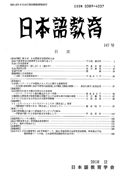Volume 173
Displaying 1-6 of 6 articles from this issue
- |<
- <
- 1
- >
- >|
FEATURED ARTICLE
-
2019Volume 173 Pages 1-15
Published: August 25, 2019
Released on J-STAGE: August 28, 2021
Download PDF (3281K)
REGULAR ISSUE
Survey Article
-
2019Volume 173 Pages 16-30
Published: August 25, 2019
Released on J-STAGE: August 28, 2021
Download PDF (736K) -
2019Volume 173 Pages 31-45
Published: August 25, 2019
Released on J-STAGE: August 28, 2021
Download PDF (734K) -
2019Volume 173 Pages 46-60
Published: August 25, 2019
Released on J-STAGE: August 28, 2021
Download PDF (666K)
Research Note
-
2019Volume 173 Pages 61-68
Published: August 25, 2019
Released on J-STAGE: August 28, 2021
Download PDF (454K) -
2019Volume 173 Pages 69-76
Published: August 25, 2019
Released on J-STAGE: August 28, 2021
Download PDF (1957K)
- |<
- <
- 1
- >
- >|
